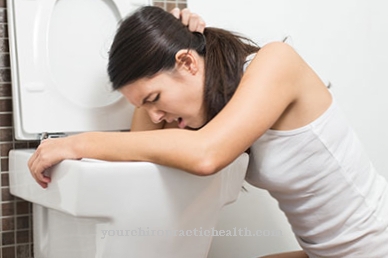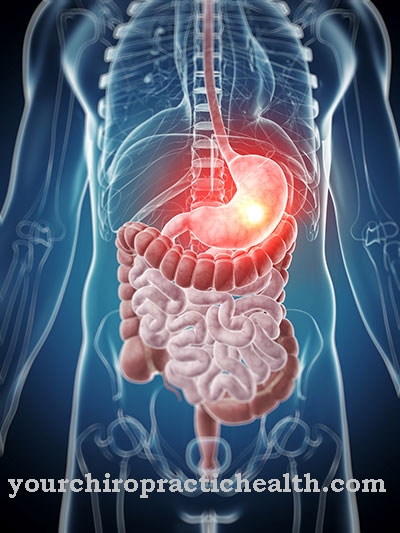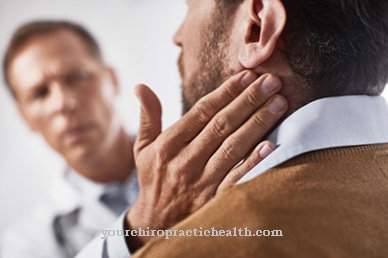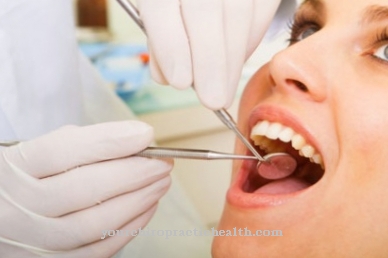A Uterus subsidence or Vaginal sagging occurs when the ligaments and muscles of the uterus holding apparatus lose their elasticity and can no longer hold them in their anatomically normal position. The uterus and vagina then move downward according to gravity. Slight depressions do not require therapy; in severe cases, surgery is necessary.
What is a uterine sagging?
.jpg)
The technical term for uterine lowering is Descensus uteri. Usually the uterus (uterus) lies in the small pelvis, held in place by a connective tissue holding device. It is suspended from above on various straps and from below it is additionally supported by the pelvic floor muscles.
With age, but also for other reasons, muscles and ligaments can loosen, so that the uterus gradually slides down. Structures of the vagina then also move downwards. There are four different degrees of uterine subsidence:
A depression of the 1st degree is very slight and is usually not noticed at all, in the 2nd degree the uterus descends to the vagina, in the 3rd degree it becomes visible in the vagina. The 4th degree uterine subsidence is the so-called uterine prolapse or total prolapse, in which the uterus and parts of the vagina protrude from the body.
causes
The cause of a lowering of the uterus is a decrease in the elasticity of the holding apparatus. Very often the pelvic floor muscles are too weak and can no longer support the uterus. This pelvic floor weakness often develops with age.
However, it can also be triggered at a young age by weak connective tissue, frequent pregnancies, heavy physical stress, chronic constipation or obesity. A weak connective tissue is inherent, sometimes it is triggered by a hormonal change and only occurs after the menopause. Heavy lifting and carrying when there is a weak connective tissue can lead to a lowering of the uterus.
The weight of the uterus increases during pregnancy, especially in multiples or very heavy children. This can overuse the ligaments that hold the uterus and lose their elasticity. You are then no longer able to completely tighten yourself after pregnancy, the result is the uterus sagging.
Being overweight leads to extreme stretching and weakening of the abdominal wall muscles. As a result, there is a lack of tension in the abdomen and the organs are no longer properly held, which can also lead to a lowering of the uterus.
Symptoms, ailments & signs
A uterine subsidence occurs in many women and often causes no symptoms at all. This is especially the case with grade I uterine subsidence. At this stage, the lowering of the uterus does not yet reach the entrance to the vagina. This is only the case in stage II of a lowering of the uterus.
In addition, partial (grade III) or total (grade IV) prolapse of the uterus through the vaginal entrance can occur. From the second stage onwards, some women already complain of pulling abdominal pain, a feeling of pressure, a feeling of foreign bodies in the vagina, bladder weakness and urination disorders. These complaints increase as the uterus subsides.
The weak bladder manifests itself in the involuntary leakage of urine when laughing, sneezing, coughing or having sexual intercourse. It is referred to as stress incontinence. In the case of bladder voiding disorders, there is an increased urge to urinate, but only small amounts of urine are emptied (pollakiuria). There is always residual urine in the bladder, which greatly increases the risk of urinary tract infections.
Bacteria that are already present in the residual urine multiply and can lead to frequent bladder and vaginal infections. In extreme cases, a severely lowered uterus can also cause urinary congestion with the risk of total kidney failure. Furthermore, defecation disorders in the form of constipation and an unpleasant feeling of fullness can occur as a consequence of a uterine sagging when a poop-filled intestinal wall sac is pressed towards the vagina.
Diagnosis & course
A slight lowering of the uterus usually causes no symptoms. However, if it continues, various symptoms will be felt. Initially, there is a certain feeling of pressure or tension in the lower abdomen. This can be accompanied by abdominal and lower back pain, which occurs especially after physical exertion.
If the uterus has sagged enough that it is pressing on the bladder, this can lead to frequent urination or weakness of the bladder. When sneezing, coughing or laughing, urine drops uncontrollably. Urination disorders can also be caused by uterine subsidence. A little urine always remains in the bladder, which can cause urinary tract infections.
Grade 4 uterine subsidence often results in inflammation in the vagina. In addition, affected women are restricted in their mobility and a normal sex life is no longer possible. The gynecologist can make the diagnosis through a gynecological examination. By internal palpation of the abdomen, but also with an ultrasound examination, a uterine subsidence can be clearly identified even at an early stage.
Complications
As a rule, the symptoms or complications always depend on the extent of the uterine subsidence. With only minor subsidence, in most cases there are no particular complaints or pain, and no direct treatment is carried out. There are no further complications here either. In severe cases, however, there is pain in the abdomen and lower back.
This pain often spreads to other regions of the body and can also stress these areas. It is not uncommon for incontinence and bladder weakness to occur. As a result, those affected often develop psychological complaints and depression. Urination also has to take place more frequently, with patients often deliberately consuming a smaller amount of water.
This can lead to dehydration, which is a very unhealthy condition for those affected. In the further course of the uterine subsidence, urinary tract infections can also occur if the uterine subsidence is not treated. There are also no further complications during treatment. This is done with the help of therapies or operations. As a rule, there is no reduction in life expectancy.
When should you go to the doctor?
Women should see a doctor as soon as they experience abdominal pain that is not related to the onset of menstruation or ovulation. If the pain worsens or continues to spread, a doctor should be consulted. If there are additional back complaints or if there are impairments in the area of the pelvis or locomotion, a doctor should be consulted.
Before taking any pain medication, it is essential to consult a doctor in order to avoid complications or further disorders. If the woman suffers from bladder weakness, frequent urination or unwanted wetting, she should consult a doctor. If the urine cannot be held when sneezing or coughing, a doctor's visit is necessary. In the event of discomfort during the sexual act, a feeling of pressure or tightness in the abdomen or the perception of a foreign body in the vagina, it is advisable to consult a doctor.
Feelings of tension in the abdomen or abdomen are considered unusual and should be clarified medically. If there are disturbances in the female cycle, inner restlessness or a diffuse feeling of illness, a doctor's visit is necessary as soon as the symptoms persist over a long period of time. A doctor should be consulted if there is any discomfort or problems when using tampons.
Doctors & therapists in your area
Treatment & Therapy
The uterine subsidence can be treated conservatively and surgically. In affected women after the menopause, the administration of estrogens often helps. Furthermore, you can strengthen the support system of the uterus by training the pelvic floor muscles. It is recommended to train the pelvic floor before the first symptoms appear so that the uterus does not sag in the first place.
There are also special pessaries that are inserted into the vagina to support the uterus from below. If the uterine subsidence is already more advanced, treatment is usually performed surgically. The organs that have slipped are brought back to their original location and fixed there. The straps are shortened so that they can take over their holding function again.
If the vagina is also lowered, a so-called vaginal tightening is carried out. The operation is performed through the vagina or with an abdominal incision, depending on the circumstances. In some cases, when the women no longer want children, the uterus is also removed.
Outlook & forecast
A lowering of the uterus as a sign of a weakening pelvic floor can intensify further. First-degree vaginal sagging is to be expected in menopausal women. An earlier or more severe vaginal sagging can, however, be even more pronounced. This depends on the strain on the vagina, such as can result from heavy lifting.
The prognosis after a symptomatically treated vaginal sagging only allows the conclusion that a vaginal sagging can occur again. Whether this will happen, and how likely it is, depends on the preventive measures the woman is taking. Correct lifting (from your knees and not your back) and doing pelvic floor exercises reduce the likelihood of further uterine sagging. Obesity also increases the risk of further vaginal sagging, while exercise reduces this.
Only an operative procedure can provide security against further vaginal lowering. This can sometimes mean removing the uterus. Overall, all surgical procedures in this context are such that they can have an impact on the functionality of the uterus. Accordingly, family planning can be influenced by operative interventions in this context.
prevention
You can prevent uterine subsidence by eating healthy and getting enough exercise. This counteracts obesity, which is a major risk factor for uterine subsidence. Exercise and regular training of the pelvic floor muscles also help at a young age.
Aftercare
If the patient suffered from a sagging uterus or vagina, some follow-up care should be given. The patient should have regular follow-up examinations carried out by a specialist, in this case a gynecologist. The lowering of the uterus must always be observed.
If an operation was necessary or if the person concerned continues to have severe pain, check-up visits to the specialist are inevitable. The most commonly prescribed ointments should also always be used. It is often the case that the person concerned is given suppositories to relieve the symptoms. These, too, must by no means be discontinued without a doctor's agreement.
After an operation, it is advisable that the person take care of himself. Carrying heavy objects is also taboo. It is important that there are no complications in follow-up care for a uterine subsidence. After an operation, it is very possible that bleeding will occur.
This secondary bleeding can be prevented or reduced by rest. It is important to always adhere to these follow-up points so that the depression can recover as quickly as possible. The support and assistance of family members are also essential factors in recovery and rapid healing.
You can do that yourself
Depending on the severity of the symptoms, women can do a lot to get better. The first thing to do is to do specific pelvic floor exercises. Every gynecologist has brochures about gymnastics and strengthening the pelvic floor muscles, but doctors, midwives, trainers and nursing staff are also happy to provide information about them.
Strength sports are unsuitable as a sport because they strain the pelvic floor muscles and increase symptoms such as urine loss. On the other hand, yoga, Pilates, Nordic walking and hiking as well as light running on soft ground are particularly suitable. Riding is considered to be the most effective sport against lowering the uterus, as the rocking movement of the horse stimulates the entire pelvic floor.
When running, the pelvic floor can also be trained with so-called vaginal weights that are inserted into the vagina. Women should only get their bodies used to this slowly, that is, they should start training with the lightest weight and gradually increase it.
Contraction of the pelvic floor muscles has proven to be very effective in all life situations: whether in the office, while cooking, gardening or walking, it can become a very useful and effective habit and even sexual activity can lead to increased awareness.
























.jpg)



